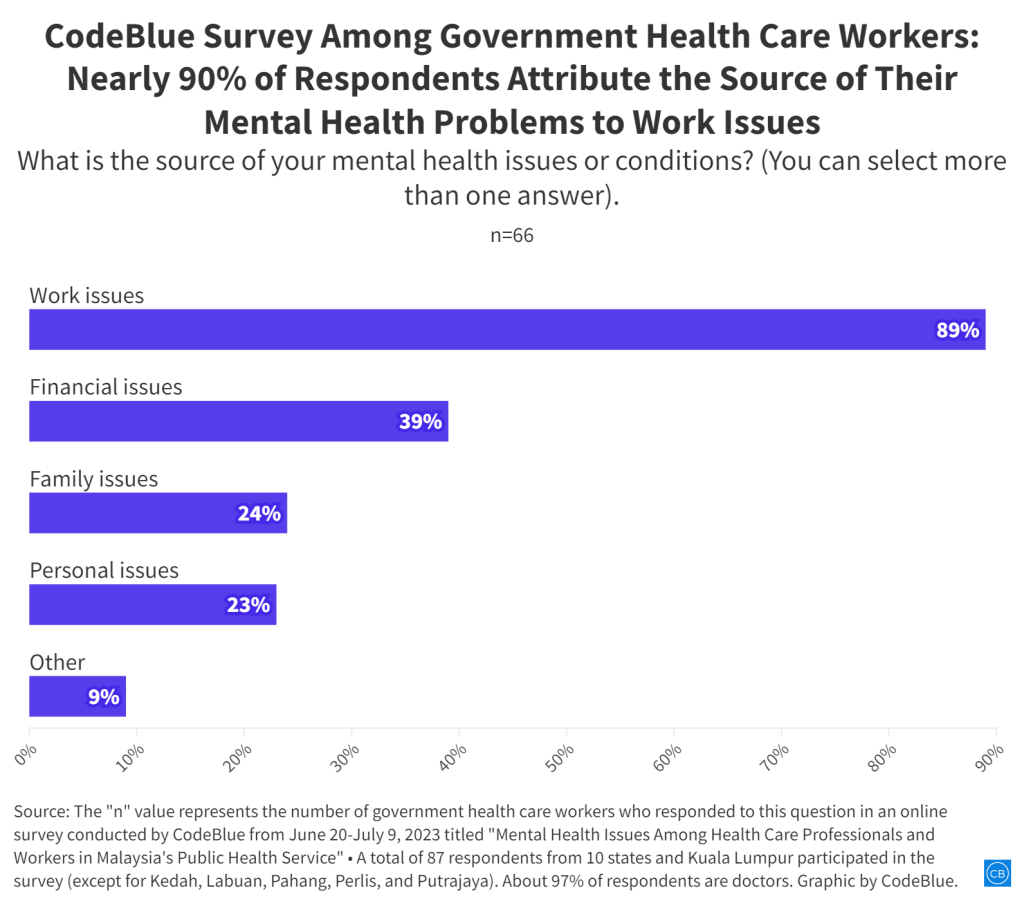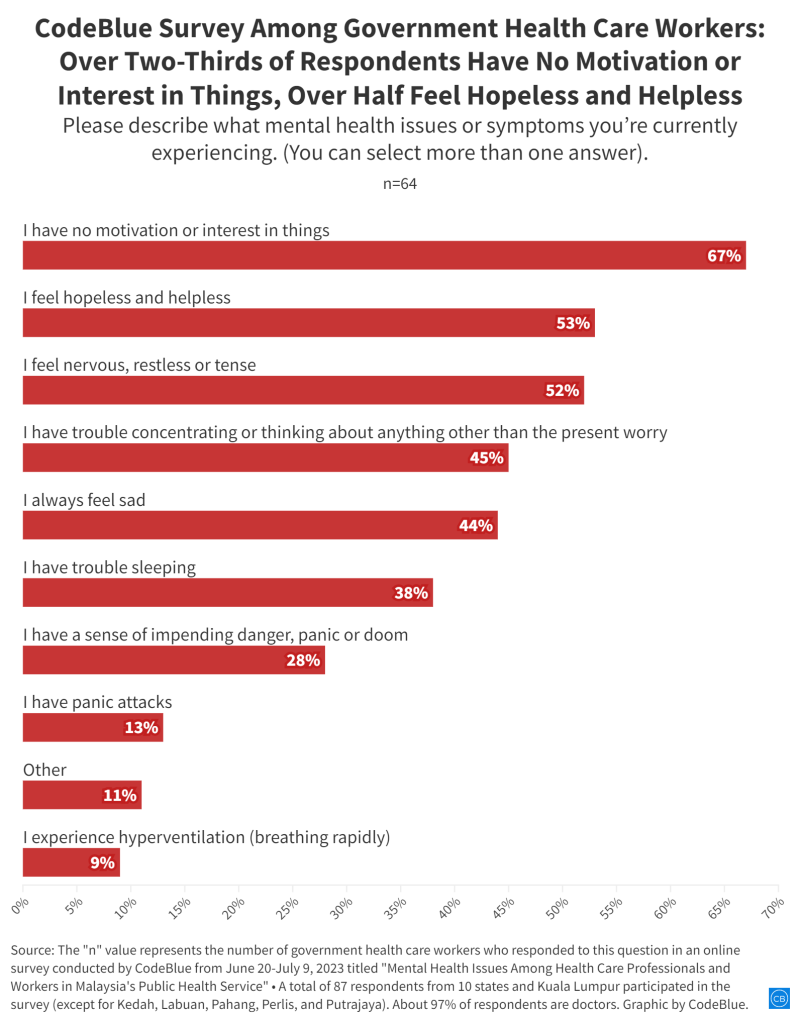KUALA LUMPUR, Sept 18 – A small CodeBlue survey found that a whopping majority of public health care workers with mental health issues, mostly doctors, identified work-related factors as the primary cause of their struggles.
The mental health poll, conducted over a two-week period from June 20 to July 9, collected responses from 87 government health care workers across the country, mainly medical officers from Ministry of Health (MOH) and university hospitals. Other respondents included a nurse, an assistant medical officer, and a physiotherapist.
Of the 87 total respondents, 63 respondents (72 per cent) reported either having mental health issues (44 per cent) or were uncertain about their mental health status (29 per cent).
Among 68 respondents who answered a question on whether they have been diagnosed with a mental health condition, 18 per cent (12 respondents) answered yes.
The survey’s primary objective was to assess the prevalence of mental health concerns and the readiness to seek treatment among government health professionals in Malaysia. This followed the tragic deaths of two health care workers in Klang on June 4 and June 6, suspected to be suicides.
These deaths occurred about a year after the demise of a Penang Hospital houseman in April 2022, which led to the formation of the Healthcare Work Culture Improvement Task Force (HWCITF). The HWCITF presented its findings in August 2022.
CodeBlue’s mental health poll consisted of 17 questions. Respondents had the option to skip six questions on topics such as their mental health symptoms, the source of their mental health conditions, whether they had received a diagnosis, the condition they were diagnosed with, whether they sought help, and the reasons preventing them from seeking help. As a result, the sample size for these six questions varied. Some of the findings are as follows.
Nine in 10 Link Mental Health Struggles to Work Issues

There were 66 respondents who answered a question on the source of their mental health issues. Within this group, a significant majority of 59 respondents (89 per cent) pointed to work-related factors as the leading source of their mental health challenges.
Several respondents expressed concerns about work instability, limited career prospects, workplace bias, and bullying. One respondent wrote, “Issues with work mostly. Instability with work and career progression. Bias and bullying in [the] workplace.”
A house officer at an MOH hospital in Penang shared: “Almost ending housemanship, cannot float in the department I want, bad timing to take papers. Knowing that there’s no job security and will be thrown here and there in the future as [a] contract medical officer, and again, won’t get to enter the department I wish to pursue.”
Financial issues emerged as the second most prevalent factor, affecting 26 respondents (39 per cent). Family issues followed with 16 respondents (24 per cent) and personal issues with 15 respondents (23 per cent).
A medical officer at an MOH hospital in Kelantan wrote, “Unable to take leave to rest and meet my husband as I’m in a long-distance relationship. I am always feeling jealousy towards non-health care workers who can take leave whenever they want.”
Medical workers have been articulating feelings of burnout and depression attributed to prolonged working hours, familial separation, and unclear career trajectories.
CodeBlue’s earlier poll in January highlighted high levels of frustration and dissatisfaction among government health care professionals on the state of the public health care system.
This trend continues to be reflected in CodeBlue’s latest mental health poll.
More Than Two-Thirds Indicate Lack Of Motivation, Half Feel Hopeless

In another survey question that asked respondents to describe their mental health symptoms, 64 individuals responded, with each respondent allowed to select multiple answers.
Among these 64 respondents, a significant majority – 43 individuals (67 per cent) – reported a lack of motivation or interest in things. More than half, specifically 34 respondents (53 per cent), expressed feelings of hopelessness and helplessness, while 33 individuals (51 per cent) indicated experiencing nervousness, restlessness, or tension.
Around 29 respondents (45 per cent) admitted having difficulty concentrating, while 28 respondents (44 per cent) consistently felt sadness. Another 24 respondents (38 per cent) reported struggles with sleep.
Some respondents described mini episodes of grief and chronic fatigue, as well as instances of self-harm ideation as coping mechanisms to avoid work, including during on-call duties.
A medical officer at an MOH hospital in Selangor wrote: “One time, I couldn’t stop crying while receiving non-stop [calls]. I just feel extremely miserable and depressed every [time there is an] on-call.”
Some Diagnosed With Multiple Mental Health Conditions

Only 18 individuals responded to the question about their specific mental health diagnoses, with the option to select multiple answers.
Among these 18 respondents, 11 individuals (61 per cent) reported being diagnosed with depression, while seven (39 per cent) indicated having anxiety. Additionally, two respondents stated being diagnosed with adjustment disorder.
There was also one diagnosis of attention deficit hyperactivity disorder (ADHD) and another of post-traumatic stress disorder (PTSD) among the respondents.
Some respondents were diagnosed with multiple mental health conditions.
Barriers to Seeking Help: 76% Perceive Obstacles in Career Progression

When asked whether they sought mental health support, including the MOH’s HEAL 15555 helpline or professional counselling or therapy, only six individuals (9 per cent) out of the 68 who responded to this question answered in the affirmative.
In another question on the factors deterring respondents from seeking mental health assistance, a significant majority – 47 out of 62 respondents (76 per cent) – highlighted concerns related to potential obstacles in their career progression. Respondents were allowed to select multiple answers.
Additionally, 37 respondents (60 per cent) pointed to workplace stigma as a deterrent, while 21 individuals (34 per cent) expressed concerns about potential suspension from work.
Another 17 respondents (27 per cent) attributed the reluctance to societal stigma, while 16 individuals (26 per cent) were apprehensive about workplace transfers.
One respondent stated: “Because the cause is the problematic system of MOH, everyone would more or less feel the same, counselling is not a solution, but improvement of the system is.”
78% Find No Change in Work Culture Following HWCITF Report
Of the total 87 respondents who participated in the survey, only 63.2 per cent (55 respondents) had used online mental health screening via DASS-21, while the remaining 36.8 per cent (32 respondents) had not participated in such screenings.
In response to the Healthcare Work Culture Improvement Task Force (HWCITF) report, the majority (78 per cent or 68 respondents) noted no discernible changes in work culture following the release of the report more than a year ago in August 2022.
A smaller percentage indicated negative shifts, with 9.2 per cent (8 respondents) and 8.1 per cent (7 respondents) describing work culture as “worse” or “much worse” respectively. Only 3.5 per cent (3 respondents) acknowledged a “somewhat better” work culture, while 1.2 per cent (1 respondent) deemed it “much better”.
Respondents: 76% MOs, 53% Contract, 71% Work In MOH Hospitals, 69% Female, 63% In Their 30s, 25% Work In Selangor
CodeBlue’s poll covered government health care workers across 10 states and Kuala Lumpur, except for Kedah, Labuan, Pahang, Perlis, and Putrajaya.
About 76 per cent of CodeBlue’s survey respondents were medical officers, while 14 per cent were house officers. Specialist doctors made up 7 per cent of respondents. The survey also received responses from an assistant medical officer, a physiotherapist, and a nurse.
Doctors across seniority comprised the majority of respondents at 97 per cent. About 53 per cent of total respondents are on contract, while 47 per cent are permanent staff.
Nearly three quarters (71 per cent) of respondents work in MOH hospitals, while 18 per cent work in government health clinics. Six per cent work at district health offices, while 3.5 per cent work at university hospitals. One respondent worked at a state health department.
More than 90 per cent of respondents are clinical-based staff, while six per cent were administrative staff. At least two other respondents work as lab-based staff.
One in four (25 per cent) respondents are working in Selangor, followed by 16 per cent in Melaka, 11.5 per cent in Penang, and 10 per cent in Sarawak.
Respondents also included those working in Kuala Lumpur (6.9 per cent); Sabah (5.75 per cent); Kelantan (5.75 per cent); Terengganu (4.6 per cent); Johor (4.6 per cent), and Perak (3.5 per cent).
About 69 per cent of respondents are female and 31 per cent are male. CodeBlue’s survey did not ask for respondents’ ethnicity as we felt it wasn’t relevant for analysis.
About 63.2 per cent of respondents are aged 30-39, followed by those aged 20-29 (31 per cent), and 40-49 (5.8 per cent).
The survey was conducted online on SurveyMonkey in English and Bahasa Malaysia for over two weeks from June 20 to July 9, 2023, guaranteeing anonymity as respondents did not have to sign in with an email address to take the poll.
In the introduction to the survey, CodeBlue listed helplines for respondents, such as MOH’s HEAL 15555 helpline and Befrienders’ helpline, besides giving them the option of not taking the survey if they did not wish to participate after having clicked the link to the poll.
CodeBlue did not publish the link to the survey to prevent the general public from taking the poll, but distributed the link via text to the editorial team’s personal contacts in the public health care sector, and asked them to forward it to their colleagues.
CodeBlue also provided the survey link upon request to those who emailed CodeBlue after verification that they work in the government health service, such as checking the Malaysian Medical Council (MMC) registry of medical practitioners.








